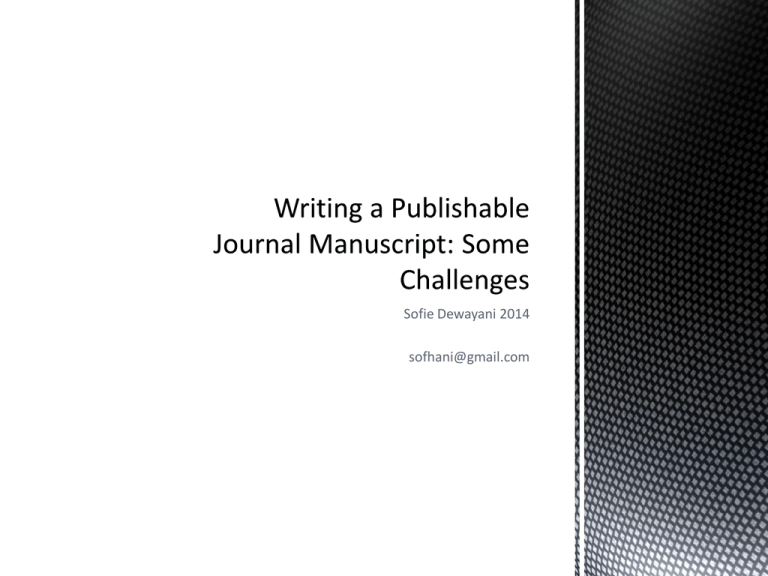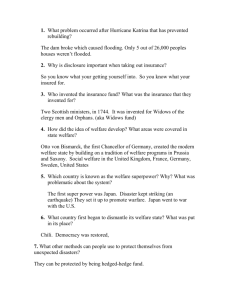Journal Writing 2014
advertisement

Sofie Dewayani 2014 sofhani@gmail.com Outlining Annotating Asking questions Reading Critical C thinking Avoid generalization Contextualizing Writing Critical synthesis Weak foundations of academic literacy in basic education. Limited access to relevant literatures Cultural difference in rhetorical conventions when writing in non-native language Rhetorical conventions of written academic English differ greatly and (often) are influenced by the most productive community/country/culture. (Unfortunately) Some rhetorical rules are unwritten ;-) The conventions include the “logics” in how the author builds his/her own intellectual argument and present it in a way that is clear and effective to avoid ambiguity and misunderstanding. Readers are not to struggle with words to decipher meaning Writers are to frame every section and paragraph: Define all terms Introduce the main topic Contextualize all statements Integrated and progressing flow of thoughts represents a clear way of thinking The order of information follows sequential patterns; it can be deductive or inductive. How does it feel to be poor in a society otherwise dominated by affluence? What kind of participation and what kind of choices are available to poor consumers? And more generally, what are the social consequences of the increased emphasis on consumption and consumerism for social marginalization and the distribution of social welfare? These are the main research questions of the present paper, which builds on empirical results from a primarily qualitative comparative research project on social vulnerability and consumption in X and Y. The overall aim is to gain a better understanding of social marginalization by analyzing the relationship between consumption and social exclusion in X welfare societies, where both the market and individual conduct are really highly influenced by political regulation. The project, in other words, attempt to integrate the fields of consumption, welfare and poverty. The background is a series of debates on how to measure social exclusion in contemporary welfare society, especially debates on defining “poverty” in a society that is rhetorically and ideologically dominated by “affluence” (References). How does it feel to be poor in a society otherwise dominated by affluence? What kind of participation and what kind of choices are available to poor consumers? And more generally, what are the social consequences of the increased emphasis on consumption and consumerism for social marginalization and the distribution of social welfare? These are the main research questions of the present paper, which builds on empirical results from a primarily qualitative comparative research project on social vulnerability and consumption in X and Y. The overall aim of this paper is to gain a better understanding of social marginalization by analyzing the relationship between consumption and social exclusion in X welfare societies, where both the market and individual conduct are really highly influenced by political regulation. _______________ The project integrates the fields of consumption, welfare and poverty. The background is a series of debates on how to measure social exclusion in contemporary welfare society, especially debates on defining “poverty” in a society that is rhetorically and ideologically dominated by “affluence” (References). In what follows, I first define the agonistic approach. Second, I define the resistance I met during fieldwork in the Hinterland, drawing on Adler and Adler (2002), and Bourdieu (1999), and discuss the limitation of these perspectives. Third, I develop the agonistic approach by reflexivity embedding the interview situation into the ethnographic context and showing how this context conditions and limits positions for research participants, thereby setting the stage for potential agonisms between the researcher and field participants. Moreover, I point to ways of possibly constructing alternative positions for research participants. Fourth, I discuss the way in which the agonistic approach taps into approaches to qualitative interview (references). Finally, I sum up how the agonistic approach challenges qualitative research by offering a new lens for insight into the ways in which research relationships are parts of, and are formed by, everyday social processes and power relations. “One problem is organizational; it is hard to see the structure or follow the argument, especially in the introduction (p. 1-4). Important information about the macro context and history of Indonesian policies/practices is scattered (some on p.2, then again p.4-7) and should be consolidated in the section called “The Idealized Childhood....” which, I suggest re-naming, “Government Policies: Idealizing and “Protecting Children.” The ending of the paper also needs some work so that the reader can see how the findings relate back to the questions in the introduction. What are the main findings and what is their significance?” If you are not a native speaker, please have your paper read carefully by one. This is crucial for the quality of both your work and our journal. Furthermore, even seemingly simple cases of incorrect usage (for example, wrong prepositions) can lead to serious misunderstandings and a general lack of clarity about your paper’s main points. Either UK or US English is fine, but please be consistent! Be as concise as possible without sacrificing meaning. Keep your sentences reasonably short. Keep your paragraphs reasonably short. Write in the active voice. Avoid unnecessary jargons. Frame and contextualize everything. Never let your reader to become confused, not even for one sentence. Anticipate your reader’s questions, and answer them before the reader can even ask them. Anticipate objections and counter-arguments; frame and discuss them before the “opposition” can. Define all your terms the moment you first mention them. As a means of = by (doing), to (do) At the present time = now At this point in time = now By means of = by, with Close proximity = near Due to the fact that = because, as For a period of = for For the purpose of = for In accordance with = by, following, under In an effort to = to In a timely manner = on time, properly In conjunction with = with In order that = for, so In order to (do) = to (do) In regard to = about In spite of = despite In the near future == soon [be more specific if possible] The fact that the data is limited creates to problems That the data is limited creates two problems. To a large extent the government has exaggerated the problem. The government has largely exaggerated the problem. Overall, the government has exaggerated the problem. Replace “above” with “previously” or “earlier” As previously mentioned, …. …, as discussed earlier,… Or “this”: This statement clearly reflects the conflicting viewpoints. Replace “below” with “following”/”as follows”/”the following” Following are the conditions under which the theory holds. We organize the data as follows: The following results indicate the weaknesses in the government policy. To take into account = to consider To set up = to determine To delve into = to analyze To hang out = to interact To be made bigger = to be expanded If you can use verbs, why use nouns? We made an assessment of the problems from three angles. We assessed the problem from three angles. They have little knowledge about the complexities of the issues. They know little about the complexities of the issues. Eliminate there is, there are, and it is There are 300 people in this study This study involves 300 people, or, the study comprises 300 people. It is not immediately clear what the results suggest. What the results suggest is not immediately clear. It is difficult to understand and explain what happened in the 1990s without taking into account the developments of the 1980s. Understanding and explaining what happened in the 1990s is difficult without considering the developments of the 1980s. Avoid hedge words I would like to suggest… In this case it seems that the assessors do not consider … A theater is a building that has been specifically designed for dramatic performances. A theater is a building specifically designed for dramatic performances. A collagen is a white, inelastic protein that is formed and maintained by fibroblasts. A collagen is a white, inelastic protein formed and maintained by fibroblasts. A parliament is a national governing body which has the highest level of legislative power within a state. A parliament is a national governing body with the highest level of legislative power within a state. A moon is a natural satellite which orbits a planet. A moon is a natural satellite orbiting a planet. It was found that the vocationally trained in Germany and Denmark fare better than the unskilled on each of three attainment measure. This study found that … The findings show that … Few-country specific variables are included in the analysis. The analysis include few country-specific variables. The findings are presented in Table 3. The findings appear I Table 3. American presidents are elected every four years. American elect a president every four years. American presidential elections take place every four years. Coal is mined in West Virginia and Pennsylvania. Note: “To be” makes a weak passive voice. The alternatives are “Form” and “constitute.” The analysis did not yield any new results. The analysis yielded no new results. The government did not allocate much funding for the program. The government allocated little funding for the program. There are several studies in Epidemiology that have shown that when people consume alcohol in moderate amounts they have lower risk of developing heart disease in comparison to those who drink a lot of alcohol. Introduction Methods Results Discussion Introduction : provide the rationale for the paper, moving from the general discussion of the topic to the particular questions, issues, or hypothesis being investigated. A secondary purpose is to attract interest in the topic. Methods section describes, in various degrees of detail, methodology, materials (or subjects) and procedures. This is the narrowest part of a paper. In Results section, the findings are described, accompanied by variable amounts of commentary. Discussion section gives meaning to and interprets the results in variety of ways while referring to statements made in the introduction. Establishing a research territory Showing that general research area is important, central, interesting, or problematic. Introducing and reviewing items of previous research in the area. Establishing a niche Indicating a gap in the previous research by extending previous knowledge in some way. Occupying the niche By outlining purpose or stating the nature of the present research By listing research questions or hypothesis By announcing principal findings By stating the value of the present research By indicating the structure of the paper Write something you have a passion with. Establish a realistic goal. Read critically, summarize, and paraphrase. Make writing a social activity. Belcher, W. L. (xxxx). Writing your journal article in 12 weeks: A guide to academic publishing success. Reid, N. (2010). Getting published in international journals: Writing strategies for European Social Scientist.









